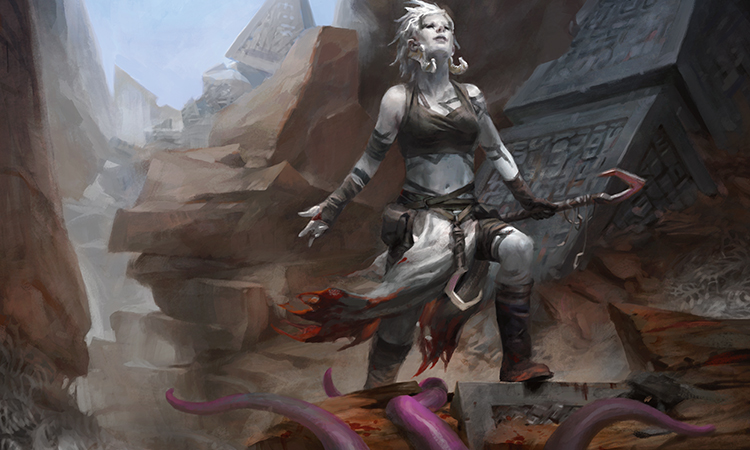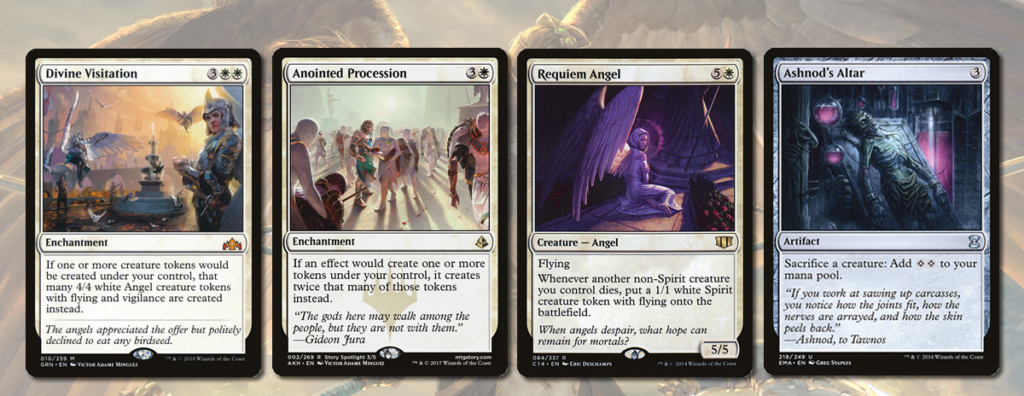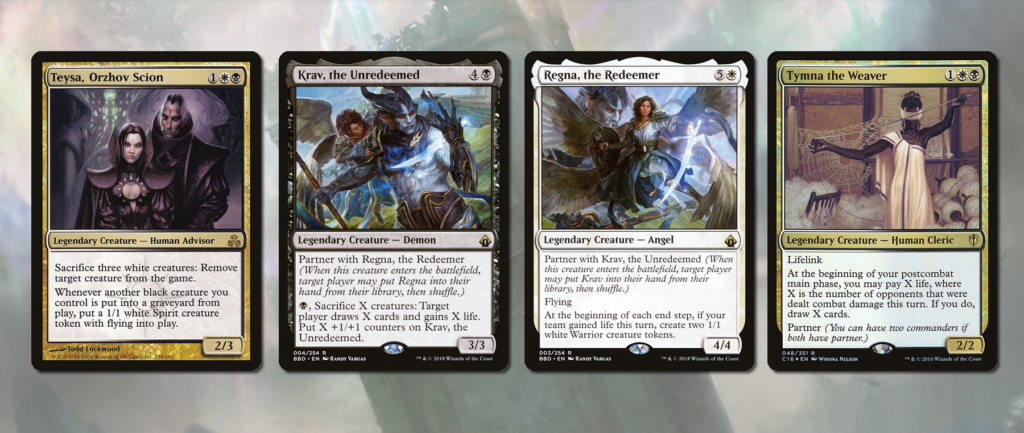In today’s edition of Legion’s Landing, Kristen covers how building a lower powered casual commander deck can often be more challenging than putting together an optimal build.
There comes a time for most Commander players where they feel the need to put together a pared-back casual deck. It might be that they’ve outgrown their playgroup a little, or that the people they play with more regularly don’t have access to the same sorts of cards. It might be that they’ve ran out of staples, or maybe they’re just disillusioned with the idea of homogenization when it comes to deckbuilding. If you’re building a casual Commander deck for any other reason than being a new player with a limited collection of cards, you might find it a bit of a challenge.
Building a Casual Commander Deck
Whatever the reason, sitting down to build a more casual deck can be a refreshing experience. Typically, the first thing you’ll feel is a breath of freedom. Without the compulsion to fill your deck with cards that are “best in slot,” you’ll be filled with excitement at the brewing opportunities. Staple cards, or those considered best in slot, are cards that occupy a good portion of space in a Commander deck. As I talked about in my article on playing more than 100 cards, the actual proportion of flex-slots in a deck—e.g. free spaces that you can slot in a pet card—is actually pretty low. Most of the real estate is taken up by the cards that make your deck tick over.
Commander, at its heart, is a format designed to let us play with so-called pet cards—cards that are a little too mana intensive, or inefficient, to run elsewhere. Cards that were nearly good enough for constructed formats, or cards that are just out and out bizarre. These vestigial cards are often still cut from modern Commander decks, as the availability and efficiency of staples has crept up since the inception of the format. It’s no longer necessary to run sub-optimal cards, except by choice. (Legendary Creature podcast have a great episode on this, which you should really check out.)
The Price of Freedom
Recently, I decided to revisit a classic deck I’d built and previously disassembled for parts: Ayli, Eternal Pilgrim. As an aside, I strongly advocate for people to try this more often: next time you feel like you need to buy cards because you’ve ran out of staples, type up the decklist of a deck you haven’t played for a while and then feel free to disassemble it. Chances are you’ll have most of what you need; and if your collection is sufficiently stocked, you’ll probably make it rain with great playables.

Back to Ayli, though. She was taken apart to try various Rakdos, Golgari, and Abzan builds earlier in the year, as I only had so many copies of cards like Dictate of Erebos, Bloodghast, Utter End and Toxic Deluge. I always had a soft spot for her, and she crossed my mind again recently when I was deciding on a more casual deck to build for the local metagame. We’ve had an influx of new and budget conscious players, and a lot of my decks are sitting at a pretty optimal 7-8 level. I wanted something closer to a 6; a little more durdly and janky, if you like.
Ayli seemed perfect, as she’s already pretty tough to build around. Good players will run at you and stop you assembling a high life total; and for the kind of deck she’s trying to be, there are many better Commanders, like Teysa Karlov. It’s the kind of deck where I care less about winning, and more about being able to play out cool synergies and jump through hoops.
When you lift the restriction of building optimally from yourself, though, the freedom can be intoxicating. You’ll be flush with ideas, and your collection can suddenly seem like a treasure trove of options. Just thinking about all of the tier 2 or tier 3 card options that seemed a little cute or hard to pull off can give you a burst of energy. Before you know it, you’ll have pulled out hundreds of possible cards to play. This is the price of freedom: decision paralysis.
Decision Paralysis
Decision Paralysis is the complete inability to make a decision. This is because the choices are too hard, or too numerable. When building decks optimally, this isn’t as much of an issue. A Meren of Clan Nel Toth deck, for example, has very few decisions to make when building. After deciding on the main win condition, you can simply pick the best in slot cards that contribute to the graveyard strategy, and go for it. An even better example is when building a Feather, the Redeemed deck. This deck is very linear, and there are clear playable cards, and cards you have to include. There’s room in both of these decks for a few pet cards, but the overall decision making process is straightforward, and can be made easier by building to the Four Column principle—ramp, draw, recursion and removal as top priorities.
When looking at Ayli, I decided to say ‘screw it’ and eschew win conditions like Aetherflux Reservoir, or Cabal Coffers & Exsanguinate, and not worry about missing more optimal cards like Toxic Deluge and Blood Artist. My mind immediately wandered and considered all of the other strategies I hadn’t considered before. Such is the allure of building for casual commander.

Directions included a tokens based build with some fun synergies like Requiem Angel & Divine Visitation, to a pillowfort enchantments build with Luminarch Ascension, Blind Obedience and Authority of the Consuls. A full-on aristocrats deck was also on the table, as my previous Ayli builds had been more of a good stuff lifegain deck. You may be thinking that many of these strategies are pretty strong, and possibly better than the deck I’m aiming to build. You’d be right if I had picked an optimal Commander, but Ayli really isn’t the one.
Boundless Realms
It’s no secret that restrictions breed creativity, and taking those restrictions away can actually be stifling. One of the things that makes this so difficult is that there’s a generalization in Commander that every card that isn’t best in slot falls broadly in one of two tiers. Tier 2 cards are either less efficient, or less flexible than Tier 1 cards, but still very strong; Tier 3 cards are strictly worse. The issue with this kind of classification is that when it comes to building decks that abandon the pricier or more powerful staples for more budget, janky or underplayed alternatives, you’ll often be stumped as to where to begin. Nobody really spends time splitting out tier 3 cards further, as the decks running them are low enough in power level that the inefficiencies or drawbacks aren’t as detrimental as they would be to a stronger deck.
Let’s look back to Orzhov, for example. As far as board wipes go, we can split them into three tiers, roughly speaking. These do not take into account synergistic side effects, such as the lifegain on Fumigate, that would bump it up the pick order in Ayli. These are subjective, of course, but look something like the following:
- Tier 1, which includes Austere Command, Merciless Eviction, Toxic Deluge, Damnation, and Wrath of God
- Tier 2, which includes Day of Judgment, Hour of Revelation, Decree of Pain, Cleansing Nova, Living Death, Winds of Abandon, and Fumigate
- Tier 3, which includes everything else that’s not “unplayable.”
The important thing to note with this kind of ordering is that my approach mirrors most closely that of Frank Karsten in his Limited Pick Order articles—the worst card in Tier 1 is very close to the best in Tier 2, and so on.
This is just an example, using boardwipes. When you do the same for creatures, enchantments, and the rest, you end up in a situation where you could quite easily be spoiled for choice.
Picking a Theme
The best way to get back on track again is to circle in on a theme that can bind everything together. It doesn’t really matter what the theme is. It could be a mechanical one, like Tokens, Aristocrats, or Control; a top down theme like Tribal, or Plane-specific; or something more tangible, like sticking to a budget, or only playing uncommons. These are all great ways to narrow down card choices, even when you’re opening up the card pool to cards beyond best in slot. Chances are that you’ve picked an easier Commander to build around than Ayli—some give you a strong theme without having to think about it too hard—but sometimes you’ll be trying something off the beaten track too, so taking a strong theme to provide the supports for your niche legend from Legends might be just the thing you need to do. In my case, I decided to have a go at an Orzhov tokens build, something I haven’t explored before.
New Horizons
There’s something exciting that can happen during this brewing process. You might find yourself drawn to a different legendary creature for your Commander as the deck starts to take shape. One of the benefits of brewing more organically, i.e., not glued to recommendations on EDHRec, is that you can watch how certain cards you’ve pulled aside wax and wane in importance as you begin to chisel out the shape of your deck.

I found myself drawn toward Teysa, Orzhov Scion as a token payoff, Krav, the Unredeemed and Regna, the Redeemer as a decidedly casual option with some good payoffs, and Tymna the Weaver as a way to ensure I could draw into later land drops and keep my hand topped up. The deck had moved away from Pillowfort, and so Tymna was proving to be an attractive prospect.
The choice between whether to run one of these, or Ayli, is ultimately still undecided for me as I haven’t finished the deck building process. I may, as many enjoy doing, choose to randomize which plays as my Commander when I sit down at the table, and mix it up from game to game. This can lower or raise synergy, depending, and can provide a lot of replayability, particularly if you’re indecisive.
It’s also a good segue into talking about another way that building a casual deck is hard: how to limit your deck.
Keeping Commander Casual
During the deckbuilding process, it can be easy to stray off course. This is not necessarily a bad thing—you may have struck gold on something you’d like to play. When it comes to building a casual Commander deck, however, you can overdo it. Using my Ayli deck as an example, the idea of switching the general to Tymna the Weaver, or Teysa, Orzhov Scion, is probably counter-productive—both of these Commanders synergize much better with a token strategy/swarms of creatures, and might make my deck, aiming to be a 6, actually stronger.
Depending on the availability of certain staples, your go at trying a more budget deck can also run into issues when you feel compelled to fill in the slots. After all, why shouldn’t you? Elesh Norn, Grand Cenobite is one of the best token payoffs in White.
Well, to stick to casual commander. You went down this path for a reason, after all. Whilst it’s true that you can get away with more than a few best in slot cards in a casual deck, particularly if they’re on theme, the easiest way to strip back the power level is to not indulge too greedily. If you decided on a budget, or a tight theme—like “screaming people tribal”—then you’re probably not going to run into this issue. If you didn’t, you may want to consider adding a second restriction. Picking an off the beaten path Commander or a weaker synergy/game plan can really help keep things less intense if you don’t have a budget to stick to.
Far and away the easiest way to power down a deck, however, is limiting the amount of recursion. Recursion is one of the biggest ways to power up a deck, as getting to play singleton cards more than once is extremely potent. It stands to reason, then, that cutting out the prevalence of recursion in a deck can have the opposite effect. It’s usually one of the later things newer players latch on to, too. If your aim is to have a deck ready for those tables, you’ll be on the right frequency.
In Closing
For some of us, being hyper-competitive and trying to figure out how to tune decks to the extreme, eking out every potential bit of value, is where we get our kicks. I certainly enjoy it from time to time! For others, they might enjoy a more casual approach, where they get to resolve big janky spells and experiment with cards that were never designed to work together. One of the joys of Commander is getting to play with so many groups of people, and one of the best ways you can prepare for that and make it a fun and inclusive experience is to ensure you have a breadth of decks that can be pulled out at different tables. I’d recommend to everyone to have at least one casual Commander deck, as you never know when the next potential candidate might sit down at your LGS table.
Just remember: don’t get caught out by decision paralysis. Give yourself some strong guidelines, and you’ll find the process a lot less consuming. One idea that a friend of mine has, which I think is really cool, is that he refuses to duplicate cards between decks. Obviously this doesn’t include cards like Cultivate or Solemn Simulacrum, but it does include stronger pieces like Smothering Tithe, Mana Drain, and Avenger of Zendikar.
We have the Sealed Commander product Commander Legends coming out in 2020, so if more casual Commander is up your street, it might just be the product for you. Check out what we know about it so far here.
Kristen is a lover of both Limited and Commander, and can most often be found championing the Boros Legion when called upon to sit down and shuffle up. Based in the UK, she works as a software developer, and her love for the Legion is second only to her appreciation for Lord of the Rings and Mass Effect.

